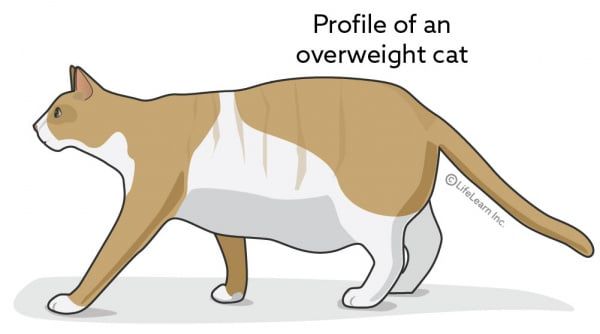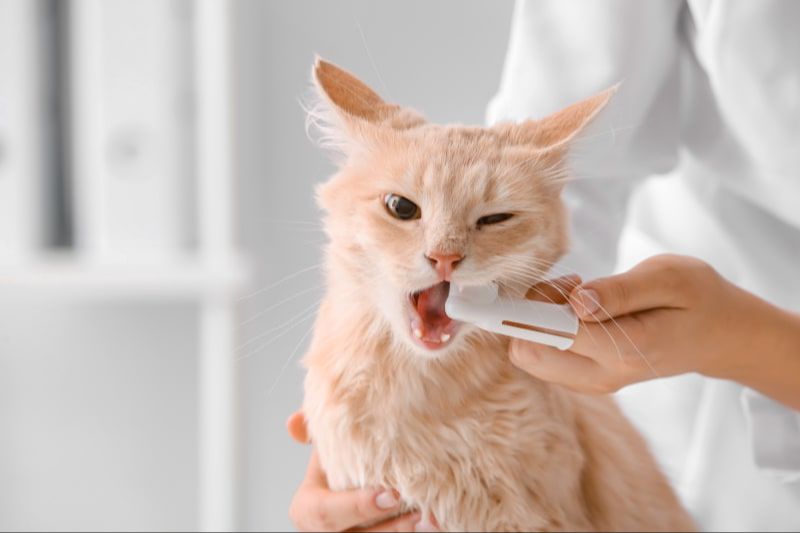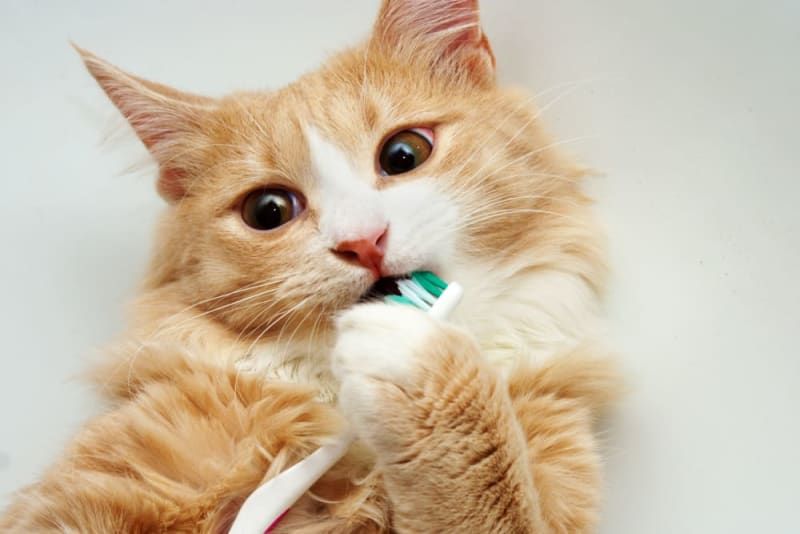Dental health is extremely important for cats, as poor oral hygiene can lead to a number of serious health issues. In the wild, a cat’s diet and natural behaviors like chewing bones keep their teeth clean and healthy. However, domestic cats don’t have these same opportunities, so their dental health needs to be maintained through other means. According to veterinarians, most cats over the age of 3 develop some form of dental disease. (https://www.rspcapetinsurance.org.au/pet-care/cat-care/guide-to-cat-dental-care)
When plaque and tartar build up on a cat’s teeth, it allows harmful bacteria to thrive in their mouth. This bacteria can enter the bloodstream and travel to major organs, potentially causing issues like kidney disease, heart disease, and liver disease. Poor dental health is also quite painful for cats and can make eating difficult. For all these reasons, it is essential that cat owners make dental care a priority through brushing, dental treats, veterinary cleanings, and other methods.
How Cat Dental Treats Work
Cat dental treats are designed to help clean cats’ teeth and reduce plaque and tartar buildup. According to Madison Animal Care, they work in two ways: “Firstly, the abrasive biscuits are said to mimic a brushing action on your cat’s teeth, scraping away any plaque or tartar. Secondly, they are made with specific ingredients that are said to actively fight plaque and tartar.”
The mechanical chewing action helps scrape plaque off the teeth, providing a partial cleaning effect. The treats also contain specific ingredients like sodium tripolyphosphate that help prevent mineralization of plaque into tartar. As explained by WellPets, “The ingredients also help to disrupt existing plaque and tartar on the teeth and disrupt bacteria from attaching to the teeth.”
Overall, the abrasive texture and anti-plaque ingredients in dental treats are designed to provide an ongoing teeth cleaning effect as cats chew on them.
Types of Dental Treats

There are three main types of dental treats for cats: chews, kibbles, and gels. Each works slightly differently to help clean cats’ teeth.
Chews are often made of materials like rawhide or Greenies that cats have to chew on to slowly wear down. The abrasive textures scrub plaque and tartar off teeth as the cat chews (Greenies). Chews come in fun shapes which entice cats to chew.
Kibble dental treats look like regular cat food but are formulated for dental health. They are crunchy and abrasive to scrape plaque as cats chew. The kibble pieces are also designed with grooves and contours to get in between teeth (Chewy).
Gel dental treats contain enzymes that help break down plaque bacteria in a cat’s mouth. Cats lick the gel off of a finger or applicator which spreads the gel around the teeth and gums (Rover). The gel keeps working even after the cat is done licking it off.
Benefits of Dental Treats
Cat dental treats provide some key benefits for your feline’s oral health:
Freshen breath – The natural abrasiveness of dental treats helps scrape away bacteria and food particles that cause bad breath. Chewing also stimulates saliva production, which helps rinse away odor-causing debris.
Reduce plaque and tartar buildup – Plaque is a sticky film of bacteria that coats the teeth if not removed by brushing or chewing. Over time, plaque hardens into tartar, which can lead to gum disease. Dental treats help scrape away plaque before it turns into tartar.
Improve gum health – Chewing dental treats gently massages the gums and stimulates blood circulation. This helps keep gums pink and firm, rather than inflamed or infected if plaque is allowed to build up.
Overall, giving your cat dental treats 1-2 times per day provides an effective supplemental way to care for their teeth and gums between professional cleanings. It’s important to also brush your cat’s teeth regularly when possible. But dental treats make a beneficial addition to your feline’s oral hygiene routine.
Sources:
https://www.lakecross.com/site/blog-huntersville-vet/2020/08/12/are-cat-dental-treats-worth-it
https://www.charlotte.providencevets.com/site/blog/2020/07/24/dental-treats-cats
Potential Drawbacks
While dental treats can provide some benefits for cats’ oral health, there are also a few potential drawbacks to be aware of:

Higher calories – Many dental treats are quite high in calories compared to regular cat treats. The hard texture requires a doughy consistency to maintain shape during baking, which often means adding flour, glycerin, and other calorie-dense binders. This can lead to weight gain if too many treats are provided.
Possible choking hazard – The hard, dry texture that makes dental treats effective can also make them a choking risk for cats, especially smaller breeds. Care should be taken to monitor pets while eating these treats and break larger ones into pieces.
According to veterinarians, moderation is key when feeding dental treats to avoid overconsumption leading to obesity or choking incidents (source: https://www.prettylitter.com/blog/do-cat-dental-treats-work). It’s also wise to select treats made by reputable pet food companies that undergo rigorous safety testing.
Vet Recommendations
It’s always a good idea to consult with your veterinarian before introducing any new treats or supplements to your cat’s diet. Vets can provide guidance on the safety and effectiveness of specific dental treat products. According to veterinary dentists, treats specially formulated to clean cats’ teeth can be a beneficial part of your feline’s oral care routine when used correctly.
Most vets recommend using dental treats 1-2 times per day. Giving treats more frequently than that may lead to overconsumption of calories, which can contribute to weight gain. It’s important to follow serving guidelines and adjust your cat’s main meals accordingly.
When shopping for dental treats, look for products that have the Veterinary Oral Health Council (VOHC) seal of approval. This means the treats have gone through testing to prove their effectiveness at reducing plaque and tartar. VOHC-approved treats like Greenies and C.E.T. Chews are veterinarian recommended.
While dental treats are generally safe, some cats may be sensitive or allergic to certain ingredients. Introduce treats slowly and monitor your cat to ensure they don’t cause stomach upset or skin irritation. Talk to your vet if you have any concerns.
Ingredients to Look For
When searching for effective cat dental treats, there are certain key ingredients to look out for that can promote dental health in cats. Some of the most important ingredients include:
Green Tea – Green tea contains antioxidants and polyphenols that have anti-inflammatory and antimicrobial properties. These compounds can help reduce plaque and fight bacteria in a cat’s mouth.1
Zinc Sulfate – Zinc is an essential mineral that can prevent the formation of tartar and calculus on teeth. Zinc sulfate is often added to dental treats to help strengthen enamel and reduce plaque buildup.2
Enzymes – Enzymes like lysozyme and lactoferrin work to break down bacteria cell walls. They help disrupt plaque and prevent harmful bacteria from sticking to surfaces in the mouth.3
Looking for treats with these natural antibacterial and anti-plaque ingredients can help promote good oral health in cats and reduce the need for professional dental cleanings.
Tips for Success

When incorporating dental treats into your cat’s routine, it’s important to transition slowly and monitor treat time to ensure effectiveness. Here are some tips:
Start by giving just one dental treat per day, and gradually increase frequency over 2-3 weeks. This allows your cat time to adjust to the new treats. Give treats at the same time each day for consistency.
Treats should complement daily tooth brushing, not replace it entirely. Aim for 2-3 minutes of treat time per day. Excessive treat time could lead to reduced brushing frequency.
Consider combining treats with a quick brushing session. The abrasive treats help loosen plaque, then brushing scrapes it away. Your cat may be more cooperative with brushing after getting a tasty dental treat!
Check label guidelines and discuss appropriate treat time with your vet. Monitor your cat during treat time to ensure they are chewing thoroughly but not too aggressively.
With a gradual introduction and smart treat time, dental treats can be an excellent supplement to keep your cat’s teeth clean and breath fresh!
Reviews of Popular Brands of Cat Dental Treats
Here are reviews of some of the most popular cat dental treat brands on the market today:
Greenies Feline Dental Treats
Greenies Feline Dental Treats (Chewy) are one of the top selling dental treats for cats. They come in three flavors – tuna, salmon, and catnip – and are shaped like little toothbrushes. The unique shape and texture help clean teeth and control tartar and plaque. Greenies are veterinarian recommended and accepted by the Veterinary Oral Health Council (VOHC).
CET Oral Hygiene Chews
CET Oral Hygiene Chews (Cats.com) are another popular VOHC-accepted option. They are available in poultry and seafood flavors. The chews have an abrasive texture that scrapes away plaque and tartar as your cat chews. They are highly palatable to encourage chewing. CET chews are made in the United States and free of artificial colors and preservatives.
Feline Greenies Dental Treats
Feline Greenies (Veterinarians.org) are a top choice of vets and pet owners. They come in three textures – crunchy, senior, and dental – to meet different needs. The treats are naturally antiseptic and help reduce plaque, tartar, and bad breath. Flavors include tuna, catnip, salmon, and chicken. Feline Greenies are VOHC accepted and made in the USA.
Conclusion

In summary, cat dental treats can be an effective part of your cat’s oral health regimen. The abrasive texture of dental treats helps remove plaque and tartar as your cat chews. This helps reduce bacteria, preventing gum disease and tooth decay. Dental treats are available in a variety of textures and flavors to appeal to different cats’ preferences.
Veterinarians typically recommend using dental treats as a supplement to teeth brushing and professional cleanings. For best results, choose treats made with natural antiseptic ingredients like chlorophyll, cinnamon, clove oil, and yucca schidigera. Avoid overly hard treats that may damage teeth. Introduce treats gradually and aim for regular daily use.
By implementing dental treats as part of your cat’s routine, along with other measures like annual vet cleanings, you can help promote healthy teeth and gums for your feline friend.

